La Ruta de los Conventos
A day trip through small towns in western Yucatan
The destinations section of Yucatan Today, the free monthly English-Spanish guide for tourists doesn't change much from issue to issue. Some articles are reprinted verbatim because their subjects don't change especially quickly anymore either despite a tumultuous past. Even so, Yucatan Today is a good source of information on destinations big and small in the state of Yucatan. This being my second trip to the region and having already seen some of the "must-see" sites I was looking forward to spending a day exploring some of the deeper cuts. Being a total sucker for promises to "take you somewhat off the beaten path," I chose to follow La Ruta de los Conventos, a route that takes you through western Yucatan villages containing prominent colonial churches and convents. I didn't especially care about the churches themselves but I chose it because I would be accomplishing two of my main travel goals:  1) to explore some small towns outside the major tourist attractions and 2) to practice my Spanish, since I'm 30% fluent according to Duolingo. I packed my little day bag with my sunscreen, point + shoot camera, raincoat (the only thing I brought with long sleeves and it was uncharacteristically chilly in the Yucatan the last few days), bottle of water, Chip's brand Jalapeno chips (I love these things) and of course my 2 copies of Yucatan Today then headed to Merida's Noreste bus station on calle 67 at 50th.
1) to explore some small towns outside the major tourist attractions and 2) to practice my Spanish, since I'm 30% fluent according to Duolingo. I packed my little day bag with my sunscreen, point + shoot camera, raincoat (the only thing I brought with long sleeves and it was uncharacteristically chilly in the Yucatan the last few days), bottle of water, Chip's brand Jalapeno chips (I love these things) and of course my 2 copies of Yucatan Today then headed to Merida's Noreste bus station on calle 67 at 50th.
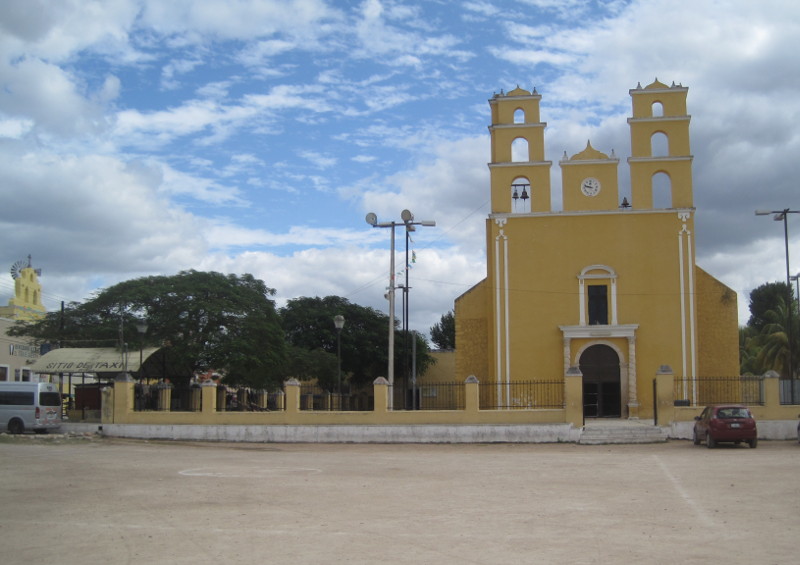 I bought a bus ticket to Acanceh, at town whose name I've been mispronouncing for a year because in the Mayan dialect both the "c"s makes the hard "k" sound. I've wanted to visit this town ever since I passed by it on my previous trip on the way to the Homun cenotes. I noticed the road signs for a ZA (Zona Archeologica) before the bus drove through the town but was particularly stunned to see a sizable Mayan pyramid right in the center of town, across the street from a Spanish church. I somehow knew I wouldn't miss it the second time so I made it my primary destination. I got off the bus in the center of town, a block away from the church, pyramid and the main square which has several depictions of deer (Acanceh means "moan of the deer" in Yucatec Mayan). I walked around the pyramids,
I bought a bus ticket to Acanceh, at town whose name I've been mispronouncing for a year because in the Mayan dialect both the "c"s makes the hard "k" sound. I've wanted to visit this town ever since I passed by it on my previous trip on the way to the Homun cenotes. I noticed the road signs for a ZA (Zona Archeologica) before the bus drove through the town but was particularly stunned to see a sizable Mayan pyramid right in the center of town, across the street from a Spanish church. I somehow knew I wouldn't miss it the second time so I made it my primary destination. I got off the bus in the center of town, a block away from the church, pyramid and the main square which has several depictions of deer (Acanceh means "moan of the deer" in Yucatec Mayan). I walked around the pyramids, 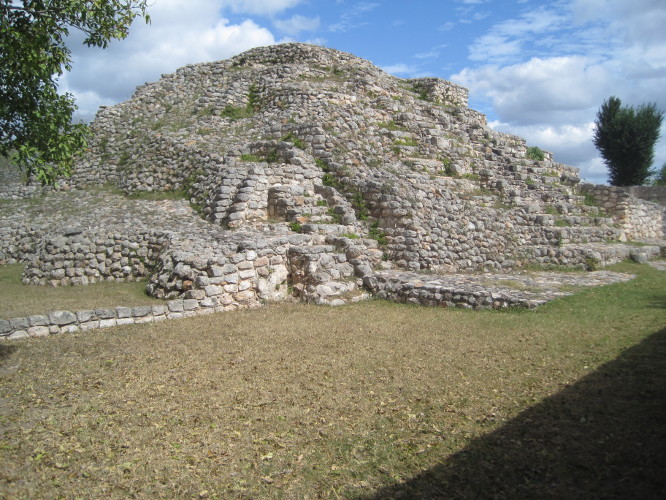 there were 2, to see how to get in and realized when I walked all the way around that there was a little unmarked ticket booth right in front. I saw a blonde woman and a local man who I noticed earlier getting out of a brand new red car (had to be a rental) buying their tickets right before me so I did the same thing. The ticket clerk sold me a ticket and showed me a photo from 1996 depicting the larger pyramid overgrown and only partially excavated. He explained that in the years since the photo was taken, architects working on restoring the site found huge masks carved into the stone on top of the pyramid. He took me inside the gate to the site and said the area is a confluence of three eras: the ancient Mayan (the first structures were built in 200-300 AD), the colonial Spanish represented by the church and the modern — he
there were 2, to see how to get in and realized when I walked all the way around that there was a little unmarked ticket booth right in front. I saw a blonde woman and a local man who I noticed earlier getting out of a brand new red car (had to be a rental) buying their tickets right before me so I did the same thing. The ticket clerk sold me a ticket and showed me a photo from 1996 depicting the larger pyramid overgrown and only partially excavated. He explained that in the years since the photo was taken, architects working on restoring the site found huge masks carved into the stone on top of the pyramid. He took me inside the gate to the site and said the area is a confluence of three eras: the ancient Mayan (the first structures were built in 200-300 AD), the colonial Spanish represented by the church and the modern — he 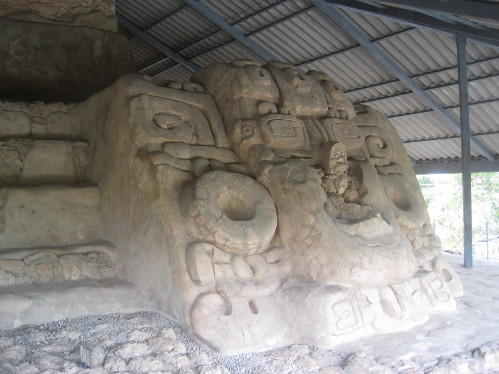 pointed to a little building in the back where the bathrooms were and I chuckled a little. I spent some time exploring the site before contemplating my next move. I actually hadn't planned my day any further than seeing Acanceh until this point. I could spend the day here or my other options were to head to Cuzama and see some more cenotes or continue along the Convent Route to explore other towns. To see more of the route I would have to take buses and colectivos without any sort of schedule and with limited Spanish but I decided to be a little adventurous. I checked Yucatan Today for the name of the next town and asked the ticket clerk where to catch the bus to Tecoh.
pointed to a little building in the back where the bathrooms were and I chuckled a little. I spent some time exploring the site before contemplating my next move. I actually hadn't planned my day any further than seeing Acanceh until this point. I could spend the day here or my other options were to head to Cuzama and see some more cenotes or continue along the Convent Route to explore other towns. To see more of the route I would have to take buses and colectivos without any sort of schedule and with limited Spanish but I decided to be a little adventurous. I checked Yucatan Today for the name of the next town and asked the ticket clerk where to catch the bus to Tecoh.
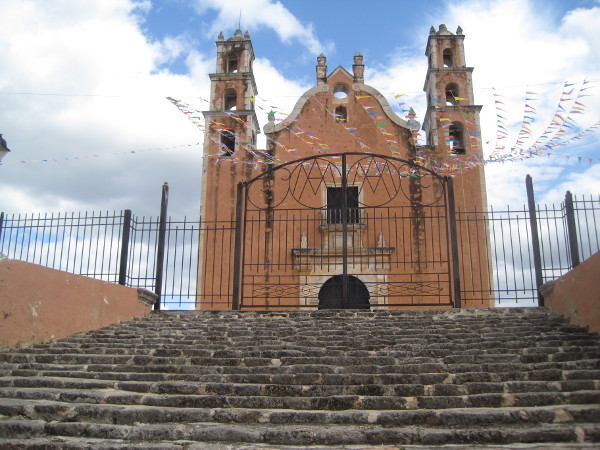 As luck would have it, there is a little white minibus that runs between Acanceh and Tecoh just about every 10 minutes. I paid the driver and got in, completely forgetting that Acanceh has a second set of ruins just a few blocks away. Oh well, next trip. Tecoh was a neat little town with a large red church in the center. The hill the church stands on is the only remain of a Mayan pyramid. The town had a small amusement park with rides for children that was being dismantled. It must have been there for the carnivals that were going on all over the peninsula during the past weekend. I bought a horchata from a little restaurant beause they didn't have what I really wanted — coffee, and went back to the bus station hoping to find a way to get to Telchaquillo, the next stop. Unfortunately, the same little white bus that took me here only ran back to Acanceh or the whole way back to Merida. I asked a lady who was sitting by the stop peeling oranges if there was a bus going to Telchaquillo.
As luck would have it, there is a little white minibus that runs between Acanceh and Tecoh just about every 10 minutes. I paid the driver and got in, completely forgetting that Acanceh has a second set of ruins just a few blocks away. Oh well, next trip. Tecoh was a neat little town with a large red church in the center. The hill the church stands on is the only remain of a Mayan pyramid. The town had a small amusement park with rides for children that was being dismantled. It must have been there for the carnivals that were going on all over the peninsula during the past weekend. I bought a horchata from a little restaurant beause they didn't have what I really wanted — coffee, and went back to the bus station hoping to find a way to get to Telchaquillo, the next stop. Unfortunately, the same little white bus that took me here only ran back to Acanceh or the whole way back to Merida. I asked a lady who was sitting by the stop peeling oranges if there was a bus going to Telchaquillo. 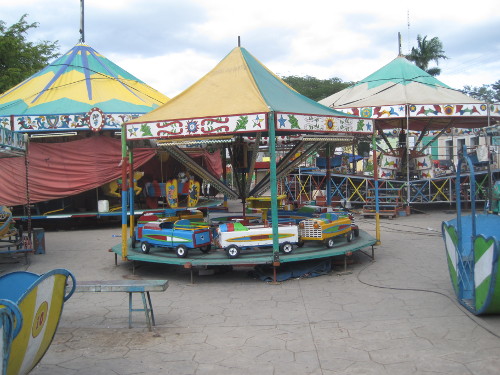 She said yes. She also said something about using my hand and going somewhere and maybe turning around. I realized that my understanding of Spanish was pretty good when the answer was one sentence, like "yes, right here," but it got much worse when the response involved some sort of explanation like "the colectivo comes here then goes around the block and comes back, just wave to it and it'll pick you up." I had just missed one when I got into town so the wait was a bit longer than I would have expected. I kept asking the drivers of the Acanceh-bound buses if I should wait here, or on the other side of the church where the amusement rides were. They seemed to be saying I'd be fine. I actually got a longer conversation going with one of them after his colleagues drove off. I could feel my fluency pushing the 31% mark. Just then the bus organizer man called me over because the big yellow colectivo was coming. It stopped right were they told me it would and I got on.
She said yes. She also said something about using my hand and going somewhere and maybe turning around. I realized that my understanding of Spanish was pretty good when the answer was one sentence, like "yes, right here," but it got much worse when the response involved some sort of explanation like "the colectivo comes here then goes around the block and comes back, just wave to it and it'll pick you up." I had just missed one when I got into town so the wait was a bit longer than I would have expected. I kept asking the drivers of the Acanceh-bound buses if I should wait here, or on the other side of the church where the amusement rides were. They seemed to be saying I'd be fine. I actually got a longer conversation going with one of them after his colleagues drove off. I could feel my fluency pushing the 31% mark. Just then the bus organizer man called me over because the big yellow colectivo was coming. It stopped right were they told me it would and I got on.
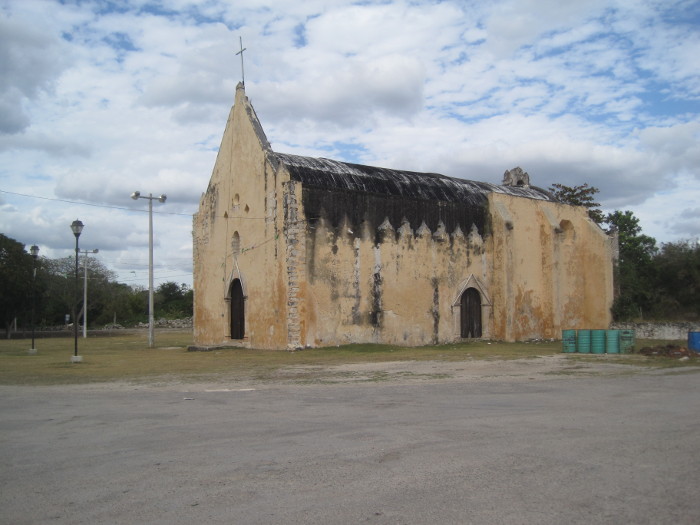 The bus didn't actually drive into the center Telchaquillo, and even if it had, I'm not sure I would have known. Telchaquillo is a tiny village with a very small church not much bigger than some houses. Most of mid-size pueblos I've seen have a small park with benches in the center, usually opposite a church and with a fleet of moto-taxis (a motorcycle attached to a cart in the front where the passenger sits). Telchaquillo didn't have any moto-taxis, nor did it have many people or a big church but what it did have certainly makes it worth the visit — a cenote. Sadly for me, the cenote was closed for some reason when I got there so I could only see the outside. I was also greeted by a proud little chicken that was parading around the street by the cenote entrance.
The bus didn't actually drive into the center Telchaquillo, and even if it had, I'm not sure I would have known. Telchaquillo is a tiny village with a very small church not much bigger than some houses. Most of mid-size pueblos I've seen have a small park with benches in the center, usually opposite a church and with a fleet of moto-taxis (a motorcycle attached to a cart in the front where the passenger sits). Telchaquillo didn't have any moto-taxis, nor did it have many people or a big church but what it did have certainly makes it worth the visit — a cenote. Sadly for me, the cenote was closed for some reason when I got there so I could only see the outside. I was also greeted by a proud little chicken that was parading around the street by the cenote entrance. 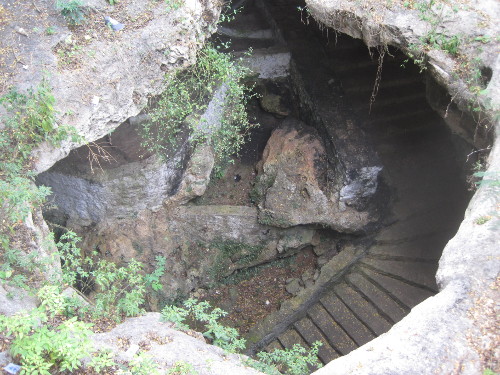 It looked like this town-hopping plan was working out so I thought I'd keep going. I was a bit worried about having to wait another 45 minutes for the next colectivo so I decided I'd walk to the next site. It wasn't another village but rather the ruined city of Mayapan — the last capital of the Mayans. The site was only another 3-4 km away and I was feeling brave so I let the compass on my Google Maps guide me to the edge of town towards the same road that got me this far. I walked through a road closure that was under construction but the workers assured me it was no problem to keep going, so on I went.
It looked like this town-hopping plan was working out so I thought I'd keep going. I was a bit worried about having to wait another 45 minutes for the next colectivo so I decided I'd walk to the next site. It wasn't another village but rather the ruined city of Mayapan — the last capital of the Mayans. The site was only another 3-4 km away and I was feeling brave so I let the compass on my Google Maps guide me to the edge of town towards the same road that got me this far. I walked through a road closure that was under construction but the workers assured me it was no problem to keep going, so on I went.
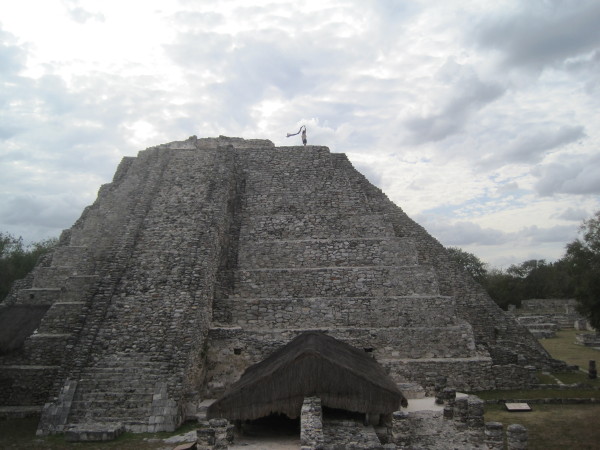 The blue ZA sign for Mayapan was laying on the ground next to a non-descript road leading to the site. I walked in and up to the ticket counter. I bought my ticket and asked the gentleman behind the counter how I could go about catching a bus back. He pointed back towards the direction I came from and said something about waiting by the road. That's about all I understood so I told him I'd ask him again on the way out. I walked into the site and there was not a soul to be seen. It was a large city with a huge number of structures to explore even though not all of it was finished being excavated. There were two pyramids to climb, the larger of which was the Temple of Kukulcan. The top of the pyramid is much higher than the treeline and the panaramic view was unobstructed since there are no major hills or tall structures nearby. Photos don't do the view nor the feeling of being up there any sort of justice.
The blue ZA sign for Mayapan was laying on the ground next to a non-descript road leading to the site. I walked in and up to the ticket counter. I bought my ticket and asked the gentleman behind the counter how I could go about catching a bus back. He pointed back towards the direction I came from and said something about waiting by the road. That's about all I understood so I told him I'd ask him again on the way out. I walked into the site and there was not a soul to be seen. It was a large city with a huge number of structures to explore even though not all of it was finished being excavated. There were two pyramids to climb, the larger of which was the Temple of Kukulcan. The top of the pyramid is much higher than the treeline and the panaramic view was unobstructed since there are no major hills or tall structures nearby. Photos don't do the view nor the feeling of being up there any sort of justice.  It wasn't until about 15 minutes of exploring that I saw the first set of other visitors — a Spanish-speaking family with a local guide. I was pretty sure the man was the father but I couldn't tell which of the women was the mother, they both looked so young. Maybe they're sisters, who knows? I noticed what looked like shells in the rocks of the buildings. I took note of a few Ceiba trees, sacred to the Mayans, growing in the less excavated part of the site and made my way back towards the entrance. There seemed to be more people in the site as I was leaving even though it was scheduled to close in less than half hour. I asked for directions again from the same man and surmised that the colectivos will collect you from the road if you stand there and flag them down. I walked towards the road determined that if the one heading towards Tekit, the next stop on the route, came first I'd get on that one. If the Merida bound bus came first I would take that one instead because it was already 4:30
It wasn't until about 15 minutes of exploring that I saw the first set of other visitors — a Spanish-speaking family with a local guide. I was pretty sure the man was the father but I couldn't tell which of the women was the mother, they both looked so young. Maybe they're sisters, who knows? I noticed what looked like shells in the rocks of the buildings. I took note of a few Ceiba trees, sacred to the Mayans, growing in the less excavated part of the site and made my way back towards the entrance. There seemed to be more people in the site as I was leaving even though it was scheduled to close in less than half hour. I asked for directions again from the same man and surmised that the colectivos will collect you from the road if you stand there and flag them down. I walked towards the road determined that if the one heading towards Tekit, the next stop on the route, came first I'd get on that one. If the Merida bound bus came first I would take that one instead because it was already 4:30 and I was nervous about buses not running after dark. Waiting by the road I saw a little red car, possibly the same one as the one in Acanceh, pass me by on the road towards Tekit. Then it stopped, turned around and headed down the road towards Mayapan. I saw the blonde lady inside with the same man, how funny! They must be following me. Or maybe I them? Either way there wasn't much time for them to see the site, it was about to close, I thought, as a yellow bus appeared on the road in the distance.
and I was nervous about buses not running after dark. Waiting by the road I saw a little red car, possibly the same one as the one in Acanceh, pass me by on the road towards Tekit. Then it stopped, turned around and headed down the road towards Mayapan. I saw the blonde lady inside with the same man, how funny! They must be following me. Or maybe I them? Either way there wasn't much time for them to see the site, it was about to close, I thought, as a yellow bus appeared on the road in the distance. 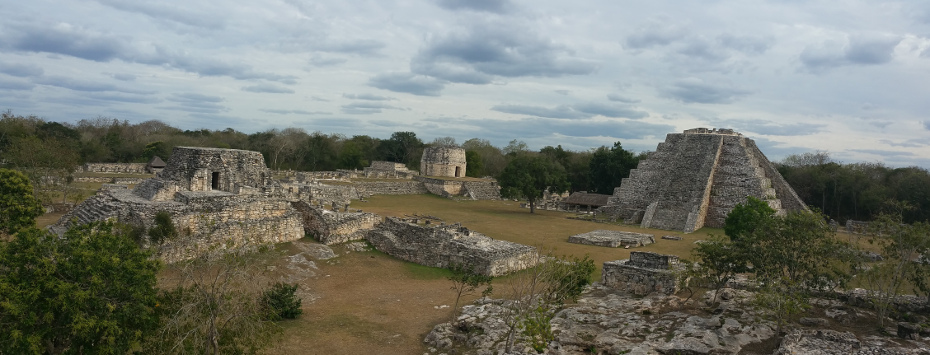
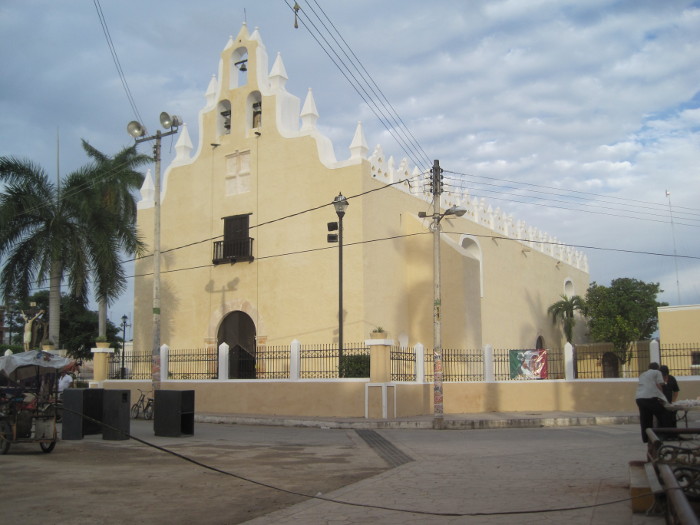 You can guess which bus it was. The ride was a little longer than the last few so I ate some of the chips I brought and relaxed before getting out at the next stop. Tekit was an attractive small town with a pale yellow painted church. It was the final stop on the bus line I initially took to get out to Acanceh so I was feeling confident I could get back on the same one before nightfall. The end of the bus line seemed a fitting place to end the field trip even though there were actually four more stops on the Convent Route that I would like to have seen. I sat on the bench opposite the church to take some discreet photos since I'm a bit self conscious about being a tourist. I'm sure nobody noticed. I had just shut down my camera when out of the blue someone walks right up to me and says something. It's the blonde lady with her companion! She said something in Spanish but switched to English when I seemed confused. She asked me where my next stop is and I told her I would probably be heading back to Merida.
You can guess which bus it was. The ride was a little longer than the last few so I ate some of the chips I brought and relaxed before getting out at the next stop. Tekit was an attractive small town with a pale yellow painted church. It was the final stop on the bus line I initially took to get out to Acanceh so I was feeling confident I could get back on the same one before nightfall. The end of the bus line seemed a fitting place to end the field trip even though there were actually four more stops on the Convent Route that I would like to have seen. I sat on the bench opposite the church to take some discreet photos since I'm a bit self conscious about being a tourist. I'm sure nobody noticed. I had just shut down my camera when out of the blue someone walks right up to me and says something. It's the blonde lady with her companion! She said something in Spanish but switched to English when I seemed confused. She asked me where my next stop is and I told her I would probably be heading back to Merida. 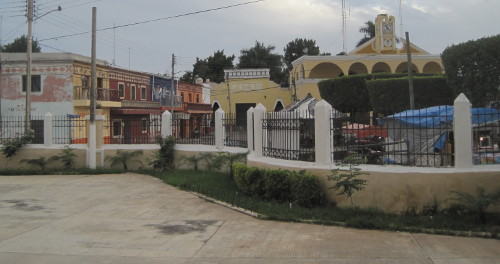 Not that I have plans for anytime soon but I'm not sure about the buses at night. She asked me if I always take the colectivos and I wasn't sure how to answer that. I guess whenever I go to small towns I do but I have rented a car before when we had a driver in our group. She told me she's not on as tight of a schedule and walked towards the church. I walked that way too and she approached me again to say I could join them if I want to but that they are going to stay out a bit later. I wanted to make sure I wasn't too eager with my response so I said I would like to be back before 10pm. She told me she didn't expect to be out past that time either. I said great and walked with them towards the little red Matiz hatchback.
Not that I have plans for anytime soon but I'm not sure about the buses at night. She asked me if I always take the colectivos and I wasn't sure how to answer that. I guess whenever I go to small towns I do but I have rented a car before when we had a driver in our group. She told me she's not on as tight of a schedule and walked towards the church. I walked that way too and she approached me again to say I could join them if I want to but that they are going to stay out a bit later. I wanted to make sure I wasn't too eager with my response so I said I would like to be back before 10pm. She told me she didn't expect to be out past that time either. I said great and walked with them towards the little red Matiz hatchback.
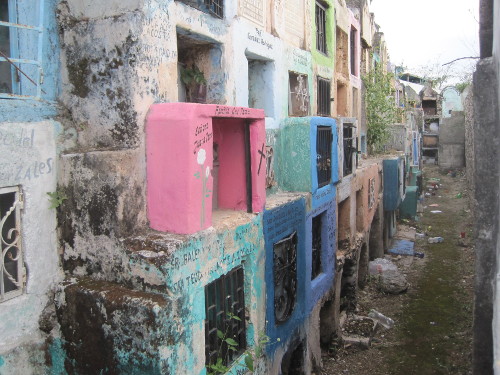 Karen and her friend Renan spoke Spanish fluently. I tried to speak Spanish as best I could so as not to leave Renan out of the conversation since he didn't speak English but I didn't always understand what was being said. Karen was an artist/photographer from Germany but spent the better part of ten years, she explained, in Tulum so she has been to many of these parts before years ago. Renan was a painter and lived in the town of Seye, a bit northeast of Acanceh.
Karen and her friend Renan spoke Spanish fluently. I tried to speak Spanish as best I could so as not to leave Renan out of the conversation since he didn't speak English but I didn't always understand what was being said. Karen was an artist/photographer from Germany but spent the better part of ten years, she explained, in Tulum so she has been to many of these parts before years ago. Renan was a painter and lived in the town of Seye, a bit northeast of Acanceh. 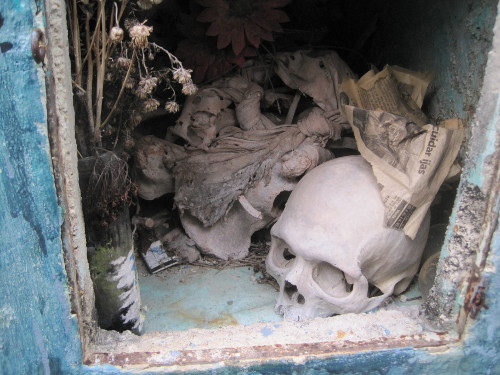 We stopped by to photograph a small cemetery on the way out of Tekit. The cemetery was surreal with small, colorful graves surrounding a few larger mausoleums. I was particularly surprised to see actual bones and even skulls in some of them. I was not surprised to learn that Karen and Renan also had a copy of Yucatan Today with them and were also following the Ruta de los Conventos.
We stopped by to photograph a small cemetery on the way out of Tekit. The cemetery was surreal with small, colorful graves surrounding a few larger mausoleums. I was particularly surprised to see actual bones and even skulls in some of them. I was not surprised to learn that Karen and Renan also had a copy of Yucatan Today with them and were also following the Ruta de los Conventos.
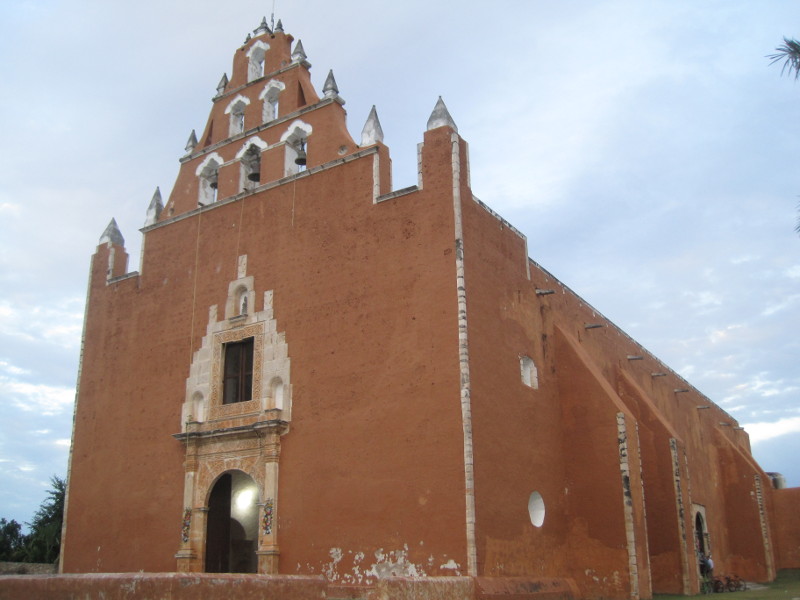 We drove a short distance to Mama, a small town that seems to barely register in most other guides. It's a shame too, because it seemed very charming. We got to Mama right before sunset and we started to see the townspeople gather outside. The church was open and there were people going inside.
We drove a short distance to Mama, a small town that seems to barely register in most other guides. It's a shame too, because it seemed very charming. We got to Mama right before sunset and we started to see the townspeople gather outside. The church was open and there were people going inside. 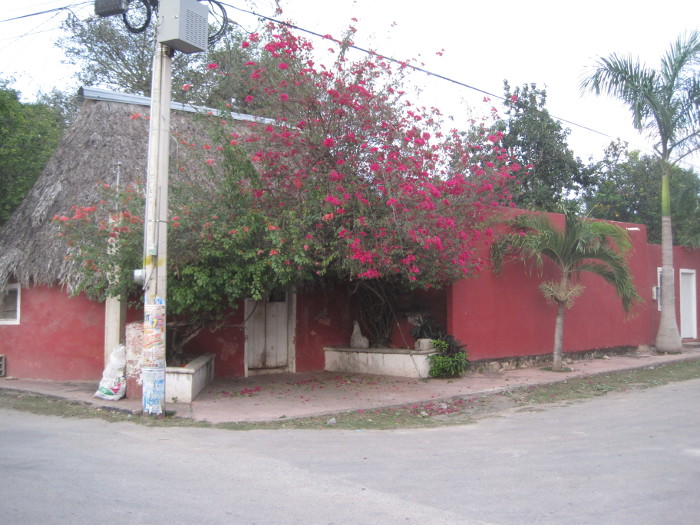 Just outside the entrance we could hear singing. We noticed that the towns were very quiet during the day with mostly moto-taxis and old people outside. It seemed like more people were congregating in the evening. We went to a small store to get some snacks and drinks.
Just outside the entrance we could hear singing. We noticed that the towns were very quiet during the day with mostly moto-taxis and old people outside. It seemed like more people were congregating in the evening. We went to a small store to get some snacks and drinks.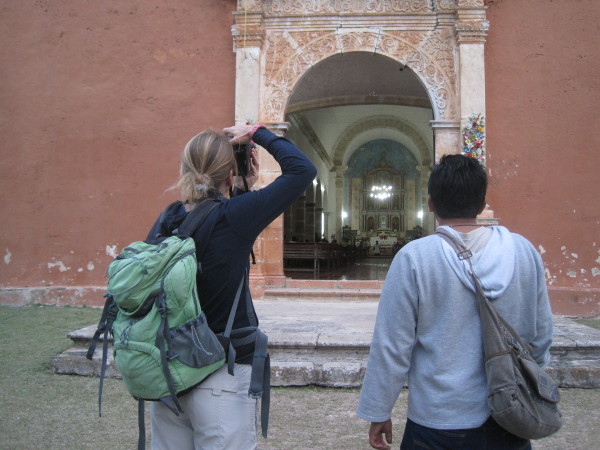 Karen asked us if we wanted to keep going and see another town. We could visit one more before the sun set then turn back. Renan and I were on board so we got in the car and went on.
Karen asked us if we wanted to keep going and see another town. We could visit one more before the sun set then turn back. Renan and I were on board so we got in the car and went on.

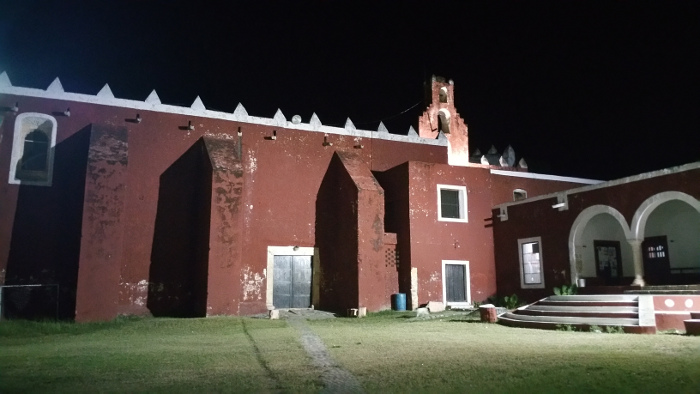 Teabo seemed like a larger town than the last two but not quite as attractive. The church was a dark red color and not expecially well lit. In general it seemed a bit rougher around the edges though it seemed like a few restaurants were open and there were lots of moto-taxis (and their cousins the pedi-taxis) in town. It was noticably cooler by this point and I had my long sleeves on. We didn't spend a lot of time in Teabo but there was one more stop on the route. "Just one more, OK? Then we'll go back." Sure, why not? We made it this far.
Teabo seemed like a larger town than the last two but not quite as attractive. The church was a dark red color and not expecially well lit. In general it seemed a bit rougher around the edges though it seemed like a few restaurants were open and there were lots of moto-taxis (and their cousins the pedi-taxis) in town. It was noticably cooler by this point and I had my long sleeves on. We didn't spend a lot of time in Teabo but there was one more stop on the route. "Just one more, OK? Then we'll go back." Sure, why not? We made it this far.
 The last stop "and perhaps most important," according to Yucatan Today, is the town of Mani. Truly, though, it's not really the last stop. The nearby towns of Ticul and Oxkutzcab also have a colonial past and would be well worth the visit. They are whole separate trips, though, and I would have to visit them next time. Mani, truly was a gem and I was happy we made it. The convent was probably the largest we've seen. The town also had nicely lit houses on the surrounding streets and was very clean and beautiful. Not only were there people in the church, singing, but there were also people cooking food outside it. As we got closer to the entrance of the church a man stopped us and asked us, in perfect English if we were coming in to pray.
The last stop "and perhaps most important," according to Yucatan Today, is the town of Mani. Truly, though, it's not really the last stop. The nearby towns of Ticul and Oxkutzcab also have a colonial past and would be well worth the visit. They are whole separate trips, though, and I would have to visit them next time. Mani, truly was a gem and I was happy we made it. The convent was probably the largest we've seen. The town also had nicely lit houses on the surrounding streets and was very clean and beautiful. Not only were there people in the church, singing, but there were also people cooking food outside it. As we got closer to the entrance of the church a man stopped us and asked us, in perfect English if we were coming in to pray. 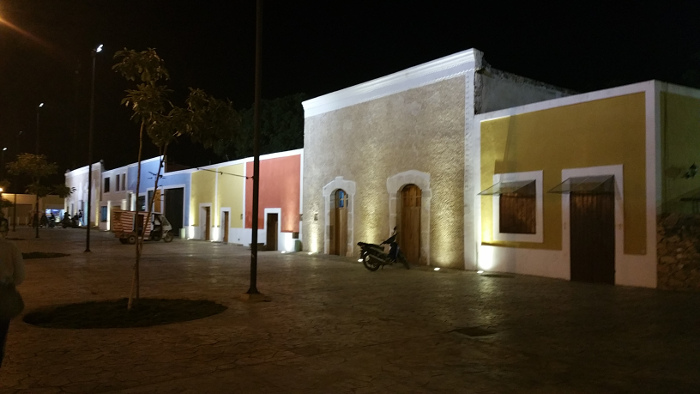 I said I'd have to look around before deciding. His name was Elio and he told us he spent two-thirds of his life in California. He had a red Oxnard t-shirt under his leather jacket to prove it. He said something in Spanish to Renan and Karen about the cenote nearby connecting to the one near Chichen Itza or something like that.
I said I'd have to look around before deciding. His name was Elio and he told us he spent two-thirds of his life in California. He had a red Oxnard t-shirt under his leather jacket to prove it. He said something in Spanish to Renan and Karen about the cenote nearby connecting to the one near Chichen Itza or something like that.  He told me he'd love to give me a tour of the area next time I was in these parts. At this point Karen and Renan pulled me away because we had a ways to go to get back and it was already night time. I took Elio's number with every intention of taking him up on his offer.
He told me he'd love to give me a tour of the area next time I was in these parts. At this point Karen and Renan pulled me away because we had a ways to go to get back and it was already night time. I took Elio's number with every intention of taking him up on his offer.
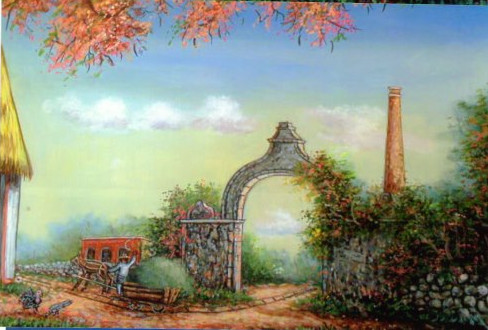 It took a bit of a while to get back to Merida. All those little 4-5 mile trips added up. Renan showed us his paintings of Mayan life when we dropped him off in Seye. I got back to Merida hungry and exhausted but grateful to have gotten to see as much as I did. I thanked Karen for prolonging my trip and headed to La Chaya Maya for some Cochinita Pibil.
It took a bit of a while to get back to Merida. All those little 4-5 mile trips added up. Renan showed us his paintings of Mayan life when we dropped him off in Seye. I got back to Merida hungry and exhausted but grateful to have gotten to see as much as I did. I thanked Karen for prolonging my trip and headed to La Chaya Maya for some Cochinita Pibil.